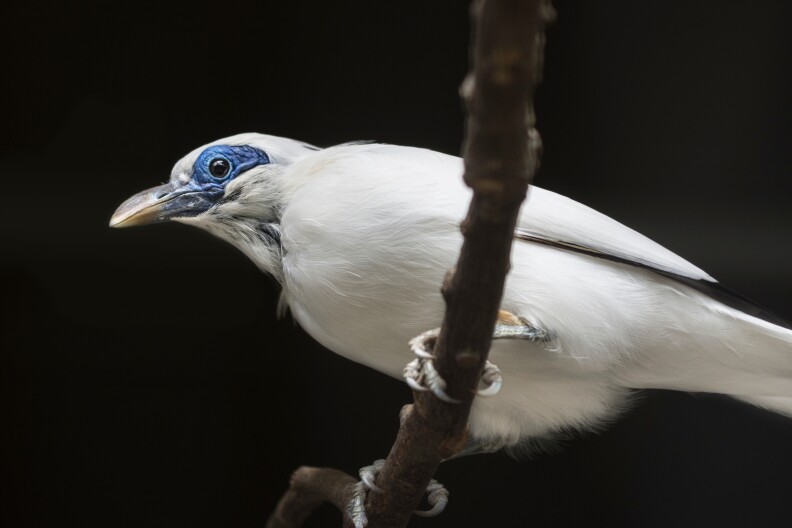Reggie the alligator is one of over 1,000 animals housed by the LA Zoo.
His journey to 133-acre site on Zoo Drive has long made him a celebrity. Reggie was illegally brought to California to be an exotic pet — only to be dumped into Machado Lake in Harbor City by his owners when he grew too big. The gator was eventually captured and sent to the L.A. Zoo, where he has been residing for the last 16 years.
Reggie is just one of the roughly 50 different illegally trafficked wildlife that is currently living at the zoo. His story — one of the better documented — is among thousands of illegally trafficked animals that are brought into the US every year.
What’s different this year is the launch of a new effort to streamline animal rehousing efforts to allow law enforcement to focus time and energy into rooting out illegal traffickers.
Beth Schafer says that birds and reptiles are the types of confiscated wildlife that the L.A. Zoo receives the most.
(Jamie Pham
/
L.A. Zoo)
The SoCal Wildlife Confiscation Network
In 2022, there were over 10,000 reported cases of illegal animal trafficking, according to the U.S. Fish and Wildlife Services. Southern California, with its multiple ports and proximity to Mexico, has been an epicenter for the illicit trade.
To combat the practice, the U.S. Fish and Wildlife Service and the Association of Zoos and Aquariums announced the launch of The Southern California Wildlife Confiscation Network at the end of October.
It is meant to be a “one stop shop” dedicated to finding housing for the confiscated animal, says Matt Martin, U.S. Fish and Wildlife Service Assistant Special Agent for California and Nevada.
“Prior to the network being set up, when a case came up a lot of time and resources would go into trying to find somebody to help us take care of that animal,” he says. “And [if] they’re venomous, if it’s saltwater fish, if it’s an aggressive animal that can’t be housed with others of its species. Those would usually take a ton of time a lot more time”
A critically endangered Madagascar radiated tortoise at the L.A. Zoo after it was confiscated from illegal wildlife trade.
And that took away time that could usually be spent on investigations, says Beth Schaefer, Director of Animal Programs at the L.A. Zoo.
“It became very obvious that it’s difficult for law enforcement to do their actual job, which is catching the bad guys, while they’re trying to take care of this animal that they suddenly have in front of them that sometimes they don’t know how to handle it safely,” says Schaefer.
Under the new confiscation network, the L.A. Zoo is one of 19 places throughout Southern California providing temporary and permanent shelter for these trafficked animals.
Even before its official launch, Schaefer says the network’s coordinator Amanda Fischer was already “very, very busy” working to identify, re-house, and treat the animals.
A recent case involved some 100 giant clams — which sent Fischer on a quest to see if she can get them housed at several aquariums.
Fish & Wildlife’s Martin says that oftentimes, smugglers will try to hide the animals in unusual small locations, which can lead to the animal sustaining injuries.
A gray monitor lizard from the L.A. Zoo, that was confiscated from illegal wildlife trade.
(Jamie Pham
/
L.A. Zoo)
“We had somebody smuggling monitor lizards from the Philippines into the United States. The animals are restricted in their movement, and not allowed to eat or drink, usually before transport, and then because they’re not being transported humanely, sometimes they’re exposed to extreme temperatures. Those animals do die,” says Martin.
He recalls one smuggler tried to sneak 50 turtles taped to his body out of the US and into Canada. And L.A. Zoo’s Schaefer says she’s seen stuffed animals filled with Cobras and deadly scorpions.
Since many in law enforcement are not trained with veterinary skills or to handle poisonous animals, it’s imperative that confiscated wildlife are re-homed quickly and efficiently.
It’s not just, ‘Hey, we need these animals to have a home.’’ It’s, ‘Hey, we don’t know what’s going on here and these could be dangerous, and we need the expertise of somebody that can handle highly venomous species,” says Schaefer.
Not every trafficked animal becomes a local celebrity like Reggie the alligator, but the new network is hoping that it can help other wildlife find their home — and maybe their happy ending.
“A few years ago, [Reggie] gained a companion Tina, who was also an illegal pet that had been confiscated,” Schaefer says. “So we have those two animals right at the front of our zoo that both came from the illegal wildlife trade.”
What questions do you have about Southern California?
